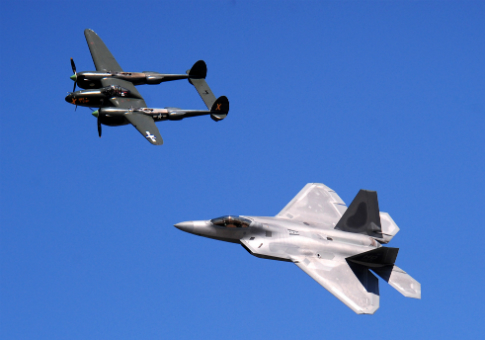In 1937, the Army Air Corps "called for a twin-engine interceptor to pursue and destroy enemy aircraft at high altitude. It also called for a maximum level-altitude flight speed of at least 360 miles per hour and the ability to reach an altitude of 20,000 feet within six minutes. These were unheard-of performance goals at that time in aviation history, and they required the design of an advanced fighter in the truest sense of that phrase."
Lockheed's response to that proposal was the P-38 Lightning, a heavy fighter that was instrumental in long-range air missions during the Second World War. The Projects of Skunk Works is filled with such stories. The book shows how Lockheed—now Lockheed Martin, the 500-pound gorilla of defense contractors—programs have produced some of the most extraordinary aircraft in world history.
Enter Lockheed’s top-secret research arm, called Skunk Works. Skunk Works earned its name in the 1940s when a wrong-number caller got through to a Lockheed engineer. Joking, the engineer answered "Skonk Works, inside man Culver." (Skonk Works was a factory from a popular newspaper comic of the time.)
After engineering the United States' aerial dominance in the latter stages of the Second World War, the post-war Skunk Works jumped into jet fighter development. Lockheed fostered aggressive risk-taking in pursuit of technological revolutions. Skunk Works engineers were unleashed and managers got out of the way. But as the P-38 episode shows, Skunk Works wasn't—and isn't—just about flights of fancy, designing "beautiful triplesonic air vehicles that fly nearly 20 miles above our planet." Take the experimental YC-130 that first flew on January 21, 1955. Nearly 60 years later, that developed transport plane—the C-130 Hercules—remains in service with the U.S. military. It speaks to good engineering: For Skunk Works, functionality is paramount. The author convinces readers that aircraft like the C-130 are silent but equal brothers to celebrity aircraft such as the U-2 spy plane.
In the 1960s, Skunk Works was focused on the Soviet threat. Spy planes were, understandably, a special priority. But the development of legacy aircraft such as the SR-71 Blackbird and F-117 Nighthawk didn't come overnight. Developed from various U.S. Air Force and CIA programs—beginning with a breakthrough, the cutting-edge A-12 airframe—the SR-71 reflected the perfection of experience. It's an important example of the complexity, risk, and cost required to develop any legacy aircraft. And it provides a lesson to us now: If taxpayers want the best aircraft, we have to be willing to pay for them. We also have to tolerate some failures, such as the James Bond-like 'Sea Shadow' vessel.
A key Skunk Works story of the 1980s and 1990s was development of the F-22 Raptor. The U.S. Air Force was on the market for an air dominance fighter that could annihilate adversarial air forces, combining stealth, survivability, and lethality. The Raptor was just the ticket. While it is no longer in production due to its prohibitive cost, it still serves as a powerful deterrent to competing air forces. Put simply, adversaries recognize its dominance and steer clear.
Of course, another major development of the late 1990s were unmanned combat aerial vehicles, what we call drones. Pace offers a telling quote here: "In the end, none of the known [drone] concepts from the Skunk Works were produced for service—or were they?"
In the 2000s, the Skunk Works story—at least the one offered to the public—becomes less exciting. A number of aircraft were designed and built, but apart from the F-35 Lightning (which the author rates as exceptional) many were cancelled. The most interesting project on the horizon is the unfortunately named "ISIS: Integrated Sensor Is Structure." If it becomes operational, the ISIS—an airship—will fly at 70,000 feet and monitor a multitude of ground and air targets over a large area.
Reflecting its broad mission to serve commercial as well as government interests, Skunk Works also hopes to develop a new supersonic plane. This aircraft, the N-Plus, will hopefully mitigate the noise signature and associated damage caused by sonic booms. The technology, which we are told should be "ready around the 2025 time frame, ... would accommodate eighty passengers and have the ability to travel more than 5,000 nautical miles with sonic boom levels one hundred times quieter than the now-retired Concorde supersonic passenger airliner."
What of the combat aircraft yet to come? In the book's final chapter, The 2010s: The Quantum Leaps, Pace suggests hypersonic aircraft are the future. Skunk Works hopes to develop aircraft of such speed and stealth that the enemy cannot react to them before it's too late. While some of these aircraft, such as planned successors to the F-22 and B-2 bomber, will likely be manned, others will not. The notable unmanned aircraft here seems to be the hypersonic successor to the SR-72. This plane will cruise at 3,960 miles per hour and fly up to 100,000 feet. Pace also points out that Skunk Works is developing long-range anti-ship missiles.
Ultimately, The Projects of Skunk Works is designed for aircraft enthusiasts. Packed with high-definition photographs, diagrams and artistic impressions, it's an aesthetically pleasing read. Those interested in national security will also enjoy this book. Pace might be an aircraft expert, but his writing helps us navigate what would otherwise be a maze of technical language.
If nothing else, in an era of doubt about American power and our role in the world, this book is evidence of American exceptionalism: Intellect, technology, and private enterprise in service of the national interest.
